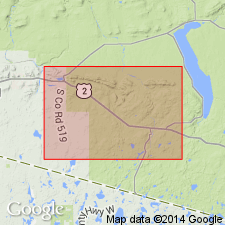
- Usage in publication:
-
- Wolf Mountain Creek Formation*
- Modifications:
-
- Named
- Reference
- Dominant lithology:
-
- Metavolcanics
- Breccia
- Basalt
- Lava
- AAPG geologic province:
-
- Lake Superior region
Summary:
Is youngest part of Emperor Volcanic Complex (new), named after Wolf Mountain Creek, secs 22, 23 and 24, T47N, R44W, Gogebic Co, northwest MI in Lake Superior region. Type locality is large flow-breccia outcrop in secs 14, 23, 24 and 25, T47N, R44W in nose of large Penokean fold. Reference section designated 150 m north of end of "mine road", secs 20 and 21, T47N, R43W. Adjoins a thick mafic sill in SW1/4 sec 15, T47N, R43W believed to be feeder conduit. Contains metavolcanics including pyroclastic and tectonic flow breccia and veined greenish-gray amygdaloidal lavas that grade upwards from dark to lighter color. Flow breccia usually have greenish-gray clasts in gray matrix. East of eruptive center in secs 14 and 23, about 90 m of pillow agglomerate was deposited which has typically undergone massive tension fracturing. Flows are commonly amygdaloidal and scoriaceous and where fractured yield jumbled masses of breccia fragments. Unit is about 90-150 m thick. Overlain by Copps Formation (adopted) and underlain by intertongued basalt flows [of Emperor Volcanic Complex] and lower members of Ironwood Iron-formation. Is Precambrian X in age.
Source: GNU records (USGS DDS-6; Reston GNULEX).
For more information, please contact Nancy Stamm, Geologic Names Committee Secretary.
Asterisk (*) indicates published by U.S. Geological Survey authors.
"No current usage" (†) implies that a name has been abandoned or has fallen into disuse. Former usage and, if known, replacement name given in parentheses ( ).
Slash (/) indicates name conflicts with nomenclatural guidelines (CSN, 1933; ACSN, 1961, 1970; NACSN, 1983, 2005, 2021). May be explained within brackets ([ ]).

